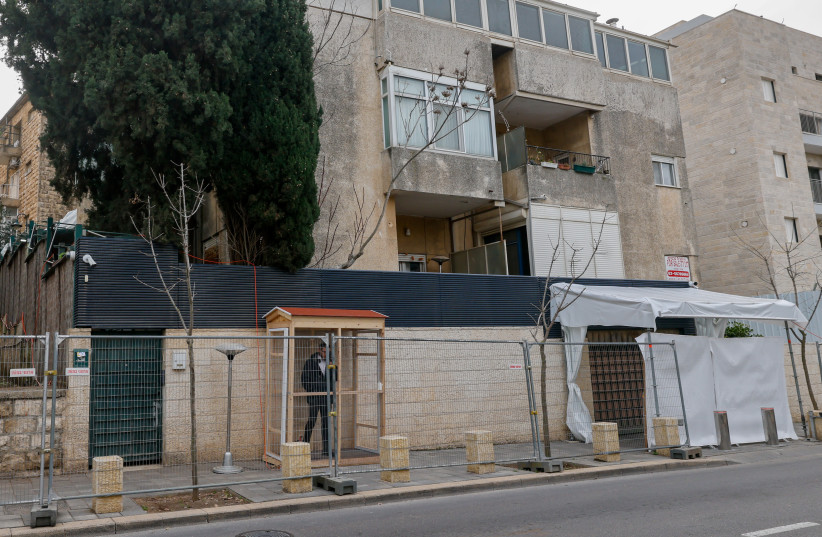Grapevine: Wherefore PM’s residence?

Movers and shakers in Israeli society.
Other than in the context of the Balfour Declaration, it seems that the name “Balfour” is making an exit from Israel’s political lexicon. Reports in electronic and print media this week indicate that renovations of the house on the corner of Smolenskin and Balfour streets, which for half a century has served as the official Prime Minister’s Residence, have been scrapped and that Benjamin and Sara Netanyahu will not be returning to their former abode.
According to the reports, teams from the Prime Minister’s Office, Finance Ministry and Jerusalem Municipality visited the site and saw that most of the interior had been gutted. The estimate is that it will take at least three years to rebuild and renovate the premises at a cost of at least NIS 90 million. Instead, it was thought to be more advisable to build an Israeli version of the White House. That, of course, will take much longer to build, since the idea is to incorporate both the Prime Minister’s Residence and the Prime Minister’s Office.
One can only imagine how much that will cost.
A plan that had been accepted during Ehud Olmert’s term as prime minister was canceled after Netanyahu resumed office, on the grounds that it was too expensive. The idea was subsequently revived. A suitable site near the PMO and the Knesset was found; building commenced, and then the Israel Security Agency threw a spanner in the works by noting that people occupying the upper floors in the nearby high-rises that were under construction would be able to see into the prime minister’s compound.
So now another suitable site has to be determined.
The residence, erroneously referred to as Balfour, may stand abandoned for a long time as did the original Prime Minister’s Residence until it was transformed into the Beit Levi Eshkol Visitor’s Center. One would hope that its successor on the corner of Balfour and Smolenskin – which had served as the foreign minister’s residence before Yitzhak Rabin’s first term as prime minister – will not be destroyed to make way for yet another high-rise, but will retain its place in the history of the capital and the state.
■
ON EMEK Refaim Street, concerned residents gather in clusters around large municipal notices posted on fences along the street and signed by Eliezer Rochberger, chairman of the Jerusalem Planning and Construction Committee.
The notices give due warning of the municipality’s intention to acquire a large number of property rights in the area to enable projects for public use. For some, this is very bad news. The Jerusalem Municipality takes as little notice of its taxpayers as the justice minister and the chairman of the Knesset Constitution, Law and Justice Committee take of the warnings of leading political and economic figures in other countries or of the tens of thousands of Israeli citizens demonstrating against judicial reform. There’s a name for that in the political lexicon.
It seems that national and local political leaders have not learned the lesson that history ignored is bound to repeat itself. Perhaps more emphasis should be placed on teaching about the periods of the First and Second Temples and their aftermath.
■
PART OF last week’s Torah portion related to the hunger of the Children of Israel as they wandered in the desert, and how they were given manna every morning, with extra portions on the sixth day because they could not collect it on the Sabbath. Since then, Jews have found reasons to eat on every festival.
The Passover Seder is probably the most widely observed of Jewish feasts. But let’s not forget the eating that goes on during Rosh Hashanah, Sukkot, Hanukkah, Purim and even Tu Bishvat. In religiously observant circles, feasting goes on for a whole week after a wedding. When there is a bereavement in the family, a buffet is set up for people who have come to comfort the mourners because people in mourning are not supposed to personally serve food to others.
Not everyone is aware of the Tu Bishvat Seder, which in most cases includes fruits mentioned in the Bible.
Dorraine and Barry Weiss of Abu Tor love to entertain. When their friend chef Yochanan Lambiase, who was among their friends when they lived in Los Angeles, asked if they would like him to cater a Seder in their home in Jerusalem, the response was an enthusiastic “Yes!”
Lambiase, the scion of five generations of master chefs from southern Italy, has worked in some of the world’s top hotels and restaurants, and even did a stint with celebrity chef Gordon Ramsay.
Lambiase was the founder of the Jerusalem Culinary Institute, which was the first mehadrin enterprise of its kind in Israel. He closed it several years ago, when he turned to other projects. He often appears on radio and television, and contributes to Jewish media around the world.
There was much more than biblical fruits in the five-course dinner that he prepared. It turned out to be what he referred to as “a symphony of flavors.”
Indeed it was. Lambiase, who is affiliated with Chabad, took pains to explain that food is not just something one eats to stave off hunger. Food has a soul and is a balance of flavors and ingredients that result from a process, just as there was a process in the creation of the world. Adding a certain spice or combination of spices can change the taste of something bland to something sweet or piquant.
Presentation is also important, with little extras such as tuiles – super-thin lace-patterned wafers that add to the elegance of what is on the plate.
Shelley Lambiase said that it was the first time that she could remember that her husband had cooked a meal devoid of any kind of tomato content. Among the unusual, tantalizingly tasty items were the smoked, paper-thin eggplant spears that were mildly crisp and simply delicious.
Also intriguing was the slightly sweet French onion soup, on a beef-broth base enhanced by vegan cheese.
Those guests who are not very partial to halva, but who out of a sense of politeness at least tasted the halva and pistachio ice cream, were amazed. The combination was a delight to the palate, and the halva was undetectable.
Dorraine, who loves company, had to minimize entertaining during COVID, so she was very pleased to have so many people around her dining room table.
There were some whom she had not seen in a long time, she said, and she was so happy that they had accepted her invitation.
greerfc@gmail.com
Jerusalem Post Store
`; document.getElementById("linkPremium").innerHTML = cont; var divWithLink = document.getElementById("premium-link"); if (divWithLink !== null && divWithLink !== 'undefined') { divWithLink.style.border = "solid 1px #cb0f3e"; divWithLink.style.textAlign = "center"; divWithLink.style.marginBottom = "15px"; divWithLink.style.marginTop = "15px"; divWithLink.style.width = "100%"; divWithLink.style.backgroundColor = "#122952"; divWithLink.style.color = "#ffffff"; divWithLink.style.lineHeight = "1.5"; } } (function (v, i) { });

